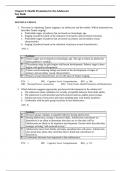Etiologie = de oorsprong van een ziekte (waarom). Pathogenese = de ontwikkeling van een ziekte (hoe).
Adaptatie
Verandering van morfologie en/of functie van weefsel als respons op
trofische signalen (hormonen, groeifactoren) of mechanische signalen.
Bijv. stressrespons van hartweefsel (myocardium)
Hypertensie (verhoogde bloeddruk) hypertrofie om hogere
contractiele kracht te kunnen genereren.
Aanhoudende hypertensie schade.
Hypertrofie
Stijging van celgrootte in cellen met beperkte delingscapaciteit.
Fysiologische hypertrofie: vergroting baarmoeder door
oestrogenen tijdens zwangerschap, spiervergroting door
verhoogde spieractiviteit.
Pathologische hypertrofie: spieractiviteit spiervergroting door anabole steroïden met neveneffecten,
hartvergroting door hoge bloedruk.
Inductie van gentranscriptie stimulatie van eiwitproductie in cel verhoogde functionele capaciteit door productie
van myofilamenten.
Hyperplasie
Stijging van aantal cellen in cellen met delingscapaciteit. Vaak in combinatie met hypertrofie respons op dezelfde
signalen. Gecontroleerd proces, want er is een stimulerend signaal nodig (verschilt van kanker). Gebeurt niet in skelet-
en hartspierweefsel! Oorzaken:
Fysiologische hyperplasie:
o Hormonaal: borst ontwikkeling tijdens pubertijd en zwangerschap
o Compenserend (groeifactoren): weefselgroei na wegname
Pathologische hyperplasie: excessieve stimulatie door hormonen of groeifactoren bij chronische irritatie,
chronische inflammatie of virale infecties.
Atrofie
Afname van celgrootte en/of cel aantal tot niveau waar overleving mogelijk is. Oorzaken:
Verlies van stimulatie (spier atrofie na immobilisatie)
Ischemie (hersenatrofie door gebrek aan bloed/zuurstof toevoer)
Verminderde voeding (spier atrofie)
Verlies van trofische signalen (hormonaal, neuraal)
Permanente schade
Veroudering
Metaplasie
Reversibele transformatie van mature celtype in ander mature celtype dat
beter bestand is tegen de veranderde omgeving. Bijv. in longen respiratoir
epitheel (pseudomeerlagig cilindrisch met cilia) plaveiselepitheel door
chronische irritatie (roken) of in slokdarm plaveiselepitheel klierepitheel met
slijmnapcellen door chronische irritatie (reflux).
Intracellulaire accumulatie (zie later) en dysplasie (niet-reversibele maligne
transformatie van individuele cellen).
,Reversibele celschade
Adaptatie
Hypertrofie, hyperplasie, atrofie, metaplasie, intracellulaire accumulatie en dysplasie.
Hydropische zwelling/degeneratie
Oorzaak: verstoring volume homeostase
o Schade aan membranen door
Vrije radicalen
Covalente binding van toxische stoffen aan macromoleculen
Verstoren van ionenkanalen
Insertie van transmembranaire proteïnecomplexen
o Falende energie productie (ATP)
o Evt. schade aan enzymen die ionenkanalen reguleren
Gevolg: acute stijging van celvolume door wateropname bleke cellen, blebbing (membraanblaasjes),
zwelling van organellen met membraan (mitochondria, RER), vacuolisatie, degeneratie van lysosomen
(hydrolyse, autolyse).
Kwetsbare cellen: cardiale myocyten, niercellen, hepatocyten, endotheelcellen, neuronen en gliacellen.
Fatty change
Vetvacuoles in het cytoplasma, eosinofiliteit stijgt.
Irreversibele celschade celdood
1. Geen herstel mogelijk van mitochondriale disfunctie (geen
oxidatieve fosforylatie en ATP productie).
2. Ernstige membraanschade
a. Weglekken van lysosomale inhoud degradatie
b. Weglekken van intracellulaire substanties en calcium
influx.
Necrose Apoptose
Cel formaat Vergroot (zwelling) Reductie (krimpen)
Mechanisme Celdood door openbarsting na zwelling (oncose) of Geprogrammeerde celdood
door apoptose
Impact Groep cellen Enkele cellen
Nucleus Pyknose karyorrhexis karyolyse Fragmentatie (karyorrhexis)
Plasma membraan Disruptie Veranderd maar intact
Cellulaire inhoud Enzymatisch verteerd (kan weglekken) Intact (evt. vrij in apoptotische bodies)
Inflammatie Ja Nee (fagocytose)
Rol Pathologisch Vnl fysiologisch
Necrose
Morfologie
Cytoplasmatisch: eosinofiliteit stijgt, vacuolisatie
Nucleair: afbraak van DNA en chromatine
o Pyknose: intens basofiel, rond
o Karyorrhexis: fragmentatie
o Karyolyse: hydrolytische enzymen, anucleaire eosinofiele massa
Patronen
Coagulatieve necrose
o Denaturatie, ook van enzymen dus blokkering van proteolyse behoud van
weefselstructuur (duidelijk afgelijnd gebied)
o Lysosomale vertering van dode cellen, debris gefagocyteerd.
o Vaak na infarcten (ischemische necrose), niet in hersenen
, Liquefactieve necrose
o Na bacteriële infectie met ontstekingsreactie of na hypoxie in CZS.
o Volledige enzymatische vertering (geen weefselherkenning mogelijk) vorming visceuze massa
fagocytose
o Indien na acute inflammatie pusvorming.
Gangreneuze necrose (klinische term)
o Coagulatie van lidmaat (door ischemie) met liquefactie na bacteriële infectie.
Kaas necrose (caseatieve necrose)
o Degradatie van cellen in granulaire brosse massa
o Weefselstructuur niet behouden, wel vaak ontstekingsrand (granuloma).
o Meestal veroorzaak door tuberculose.
Vet necrose
o Vetdegradatie door pancreatische lipases.
o Vrije vetzuren combineren met calcium witte kalkachtige vlokken (vet saponificatie).
Apoptose
Oorzaken
Fysiologisch
o Tijdens embryogenese.
o Involutie na hormoonafname: afbraak baarmoederwand tijdens menstruatie, regressie lacterend
borstweefsel na borstvoeding.
o Eliminatie van potentieel gevaarlijke cellen (zelf-reactieve T lymfocyten, immuniteit).
o Normale cel homeostase (balans proliferatie en afbraak).
Pathologisch
o DNA schade (p53 accumulatie)
o Accumulatie van verkeerd gevouwen proteïnen ER stress (Alzheimer, Parkinson)
o Cel schade bij infecties: door virus zelf (HIV) of door immuunrespons (hepatitis).
o Atrofie na obstructie van ductus.
Morfologie
Cytoplasmatisch: densificatie/condensatie
Nucleair: chromatine aggregatie (vorming klompjes) en fragmentatie (karyorrhexis)
Budding, apoptotische lichamen
Fagocytose (geen inflammatie)
Mechanismen
Stimulatoren: verlies
van groeifactoren,
loslaten van matrix,
steroïden,
cytotoxische
producten.
Inhibitoren:
groeifactoren,
oestrogenen,
androgenen.
, Mitochondriale pathway (intrinsiek)
Activatie van BH3 proteïnen (BCL-2 familie sensoren) activatie BAX en BAK (en inhibitie van de anti-apoptotische
moleculen BCL-2 en BXL-XL) vormen kanalen in mitochondriaal membraan efflux van cytochroom c ea pro-
apoptische proteïnen. Cyt C en cofactoren activeren caspase-9 cascade. Na overlevingssignalen synthese van BCL-
2 en BXL-XL die BAX en BAK inhiberen minder efflux van pro-apoptotische proteïnen.
Dood receptor pathway (extrinsiek)
Binding van ligand (expressie op actieve T lymfocyten) op receptor cross linking van adapter proteïnen activatie
van caspase-8 meestal activatie van BID (ook BCL-2 familie). FLIP is een cellulaire caspase antagonist die caspase
activatie downstream van dood receptoren blokkeert.
Opruiming
Herkenning van fosfatidylserine (een fosfolipide) en glycoproteïnen op het membraan door macrofagen en secretie
van factoren die fagocyten aantrekken. Nog voordat het membraan beschadigd en de cellulaire inhoud wordt vrijgezet
(geen inflammatie).











